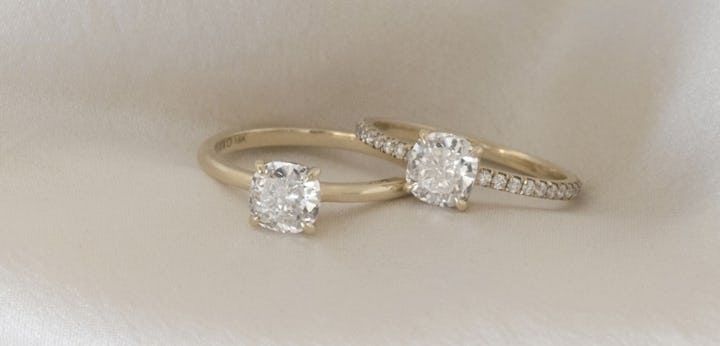

Cushion Cut Diamond: Ask A Diamond Expert
Angelica Frey | July 13, 2023
A Cushion cut diamond is a timelessly elegant, romantic diamond shape featured in many engagement ring styles and settings. Its pillow-like form and modified brilliant facets give it more fire than any other diamond shapes.
VRAI’s diamond expert and GIA graduate gemologist Queena Chang and VRAI’s Sr Director of Sales & CX Grace Taylor are well-versed in the many details that set this distinctive shape apart. Read on to discover their insights on Cushion cut diamonds, and discover why this VRAI created diamond shape might be right for you.
What Is a Cushion Cut Diamond?
Cushions are one of the most classic shapes, with modern cushions owing their soft pillowy shape to the Old Mine Cut. “These diamonds tend to be a soft square shape with bowed edges and rounded corners, or can be modified to be an elongated soft rectangular shape. They tend to face up smaller than Rounds and Ovals, so I generally recommend looking at higher carat weight diamonds, generally 2.00ct+.” says GIA graduate gemologist Queena Chang.
The History of the Cushion Cut Diamond
The modern-day cushion cut is reminiscent of the storied Old Mine cut. Old Mine cut diamonds date back to the 1700s, and were the most popular cut until the 19th century. The Peruzzi Diamond is an early 1700s Old Mine diamond that was crafted to maximize scintillation by candlelight. Its cuts were straight edged with corners that were more finely rounded in comparison to the standard Old Mine Cut.
An Old Mine cut is notable for its high crown and deep pavilion. Old mine cuts often originated in the diamond mines in Brazil. These Brazilian mines became known as the old mines once diamond mines were discovered in South Africa.
The Cushion diamond has since become a popular choice for engagement rings and other jewelry. The Cushion cut diamond is known for its ability to create a softer, more vintage look, and it is often chosen for its romantic and classic appearance. It is also prized for its ability to create a beautiful, shining effect when it catches the light.
The Most Famous Cushion Diamonds in History
Given its long history and its illustrious precedents, the Cushion diamond is a shape that can be observed in several diamonds that have historical significance.
The Napoleon Diamond Necklace, which sports 234 with a total carat weight of 263 carats, has 28 Old Mine diamonds. It was a gift from Napoleon to his second wife, Marie-Louise of Habsburg, in 1811. The necklace remained in the Habsburg family until it was sold in 1948 to a private individual. It is now at the Smithsonian Museum.
The Tiffany Yellow Diamond is a 128.54-carat Cushion diamond cut with 82 facets, and has been worn by the likes of Audrey Hepburn, Lady Gaga, and Beyoncé. In 1961, it was set in Jean Schlumberger’s Ribbon Rosette necklace. In 1995, the Tiffany Diamond was set in the Bird on a Rock brooch for Jean Schlumberger’s retrospective at the Musée des Arts Décoratifs in Paris. And in 2012, it was mounted in a necklace set with over 100 carats of diamonds to commemorate Tiffany’s 175th anniversary.
The Archduke Joseph is a 76-carat elongated Cushion diamond with a D color, and an IF clarity grade. It originated from the Golconda mines, the same place of origin as the Koh-i-Noor and the Hope diamond. It’s named after Hungarian prince Archduke Joseph August Habsburg. It was auctioned at Christie’s in November 2012.
How to Buy a Cushion Diamond
When you’re thinking of buying a Cushion diamond, you need to evaluate its 4Cs, which stand for cut, clarity, color, and carat weight. The importance of each of the 4Cs varies by diamond shape.
“Since the Cushion tends to be smaller, I generally try to emphasize on the carat weight and color, and put less focus on the clarity as the brilliance of the diamond will work in your favor,” explains GIA graduate gemologist Chang. “While a lot of my clients love a 1.50-2.00ct Round size, I tend to find that with Cushions, clients tend to prefer a 1.75-2.50ct+ size to get the same coverage that they are looking for.”
Evaluating a Cushion Diamond’s Cut
Cushion diamonds don’t have a standard GIA grading for the cut. However, the Cushion diamond boasts unique scintillation and fire because of the smaller faceting pattern which falls into the “modified” brilliant category.
“Smaller facets are what create fire in a diamond, and larger facets are what create scintillation or white flash,” explains diamond expert Grace Taylor. “Cushions tend to have smaller facets, causing more of the fire and less of the scintillation, making them super glittery. Compare them with an Emerald diamond, which has much larger facets and therefore way more white flash.”
Buyers should be mindful of the Symmetry and Polish grade. The former indicates the alignment and shape of the diamond’s facets, the latter their degree of smoothness and presence of minor surface defects.
Evaluating a Cushion Diamond’s Clarity and Color
In terms of color and clarity grades, eye cleanliness should be your guiding principle. For cushion cut diamonds, the majority of VS diamonds (and even some SI ones) will be eye clean, as the fire and scintillation of the diamond will easily conceal the inclusions. While our experts suggest Colorless (DEF) or Near Colorless (GHIJ) color grades, it’s very hard for the untrained eye to distinguish between clarity grades.
Most of the color evaluation is done in a lab setting against a stark white background, with the diamond’s pavilion facing up, as color shows more in the pavilion than in the crown. Prioritizing cut affords more leeway in terms of clarity and color, as this shape’s faceting and fire will minimize the appearance of color and clarity characteristics.
Evaluating a Cushion Diamond’s Carat
When it comes to cushion cut diamond rings, the carat weight of the diamond is an important factor to consider. The size of the diamond can impact the overall appearance and impact of the ring, with larger diamonds often appearing more dramatic and impressive.
However, the cost of a 2-carat Cushion cut diamond ring will generally be higher than that of a 1-carat ring, as larger diamonds are more rare and therefore more valuable. Ultimately, the choice between a 1-carat and a 2-carat Cushion cut diamond ring will depend on personal preference, budget, and the desired look of the ring
Be the first to know
Hear about our latest designs and upcoming events.
Top 3 Settings for Cushion Diamonds
Given the elegant and romantic silhouette and facets of a Cushion diamond, settings that highlight these characteristics are what complement this diamond shape best. A solitaire Cushion cut diamond engagement ring is a classic and timeless choice that features a single diamond on a simple band, and the Classic, four-prong style will highlight its pillow-like shape.
If you favor a multi-stone setting, the Five Stone Heirloom engagement ring has Art Deco style elements thanks to the four, graduated Baguette side stones, which create a very elegant contrast with the Cushion’s unique facets. The Floating Split Band combines vintage-inspired and modern styles in one setting.
Pros and Cons of the Cushion Cut Diamond
Cushions can really vary in both shape and faceting style. “Some have chunkier facets, more like an antique Old European or Round Brilliant, and others are more of a glittery look akin to a Radiant. It’ll depend on the individual diamond,” explains Taylor.
Cushions can also have a vintage aesthetic because of the diversity of cut options, which makes each one feel truly unique. “Cushions tend to be deeper overall, so they can sometimes look a little smaller from the top-down than a round brilliant of the same carat weight,” she warns potential buyers.
How Big Is a Cushion Diamond on My Hand?
Given the depth of the pavilion, Cushion diamonds face up smaller than Round diamonds. At 1 carat, a Cushion diamond’s size ranges from 6.17 x 5.87mm to 6.37 x 6.07mm, a 1.5-carat diamond is between 7.09 x 6.74mm and 7.29 x 6.94mm, and a 2-carat diamond has proportions within 7.8 x 7.42mm and 8 x 7.62mm.
These numbers are gathered from the internal data of VRAI created diamonds and are collected in our Diamond Size Chart.
What Diamond Shapes Share Similarities With the Cushion?
The Round diamond can, at first glance, be the most similar to a Cushion. If you set both in a four-prong setting, for instance, it’s not that easy to tell them apart, especially at lower carat weights. Compared to the Round diamond, however, the Cushion is definitely more unique.
“The way that cushions sparkle is sometimes called the “light on water” effect - the way that light over moving water is ever changing between light and dark, cushions can have that same effect!” says Taylor. In terms of shape, elongated Cushions are most similar to Radiants, and square cushions are most similar to Princess, Round, or Asscher shapes
VRAI Created Diamonds
All VRAI created diamonds are grown in our certified zero-emission foundries, powered by 100% renewable energy. This means all lab grown diamonds that VRAI sells come with no mining, no human toll, no emission, no guilt. Lab grown diamonds are physically, chemically, and optically identical to mined diamonds. This reduces the cost of lab created diamonds which means you get more carats for less.

